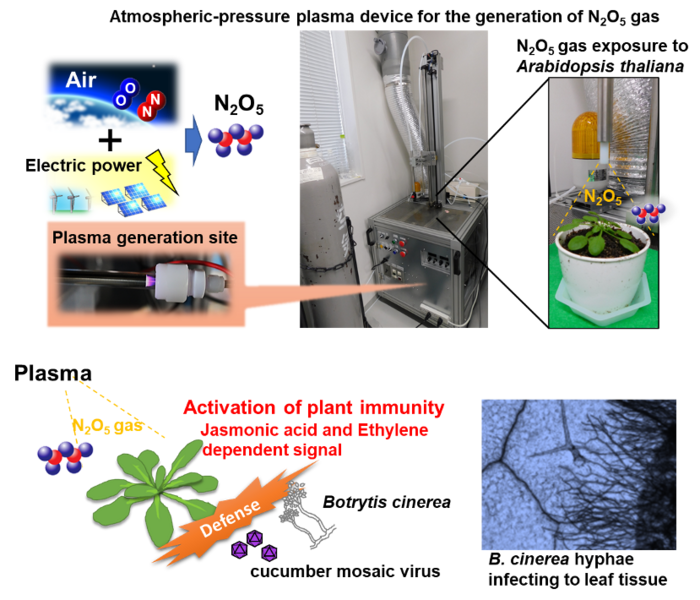The flash of lightning and the dance of auroras contain a fourth state of matter known as plasma, which researchers have harnessed to produce a gas that may activate plant immunity against wide-spread diseases.

Credit: Sugihiro Ando, Tohoku University
The flash of lightning and the dance of auroras contain a fourth state of matter known as plasma, which researchers have harnessed to produce a gas that may activate plant immunity against wide-spread diseases.
The team, based at Tohoku University in Japan, published their findings on June 24 in PLOS One.
“Currently, chemical pesticides are the mainstay of disease control in agriculture, but they can contaminate the soil and harm the ecosystem,” said paper author Sugihiro Ando, associate professor in the Graduate School of Agricultural Science at Tohoku University. “We need to develop plant disease control technologies that can help establish a sustainable agricultural system. The use of plant immunity is one of the most effective disease control methods because it utilizes the innate resistance of plants and has a low environmental impact.”
Using their previously developed device that derives plasma from the air, the researchers produced dinitrogen pentoxide, a reactive nitrogen species (RNS). This molecule is related to reactive oxygen species (ROS), in that both damage cells and trigger specific stress responses in organisms.
“It is well known that reactive species are important signaling factors in the immune response of plants, but the specific physiological function of dinitrogen pentoxide is poorly understood,” Ando said. “Plants produce reactive species as a defense response when they perceive an infectious stimulus from a pathogen. The generated reactive species function as signaling molecules that contribute to the activation of plant immunity.”
According to Ando, reactive species are linked to plant hormones such as salicylic acid, jasmonic acid and ethylene, which help regulate plant immunity, but the physiological function of dinitrogen pentoxide is poorly understand.
“Since reactive species are known to have important functions in plant immunity, we analyzed weather exposure of plants to dinitrogen pentoxide gas could enhance disease resistance,” Ando said.
The researchers exposed thale cress, a small plant commonly used as a model system for scientific research, to dinitrogen pentoxide gas for 20 seconds a day for three days. The plants were then infected with one of three common plant pathogens: a fungus, a bacterium or a virus. The plants with the fungus or the virus showed suppressed progression of the pathogen, while those with the bacterium had a similar proliferation as the control plants.
“These results suggest that the dinitrogen pentoxide gas exposure could control plant disease depending on the type of pathogen,” Ando said.
A genetic analysis revealed that the gas specifically activated the jasmonic acid and ethylene signaling pathways and appeared to lead to the synthesis of antimicrobial molecules, which Ando said may have contributed to the observed disease resistance. “Dinitrogen pentoxide gas can be used to activate plant immunity and control plant diseases,” Ando said. “Through plasma technology, the gas can be produced from air and electricity, without special materials. The gas can also be converted to nitric acid, when dissolved in water, and used as a fertilizer for plants. This technology can contribute to the construction of a sustainable agricultural system as a clean technology with minimal environmental impact.”
Next, the researchers plan to study how their technology works with crops and in greenhouse cultivation.
Journal
PLoS ONE
DOI
10.1371/journal.pone.0269863
Article Title
Activation of plant immunity by exposure to dinitrogen pentoxide gas generated from air using plasma technology
Article Publication Date
24-Jul-2022




